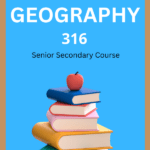NIOS Class 12 Geography Chapter 25 Transport, Communication And Trade in India, Solutions to each chapter is provided in the list so that you can easily browse throughout different chapters NIOS Class 12 Geography Chapter 25 Transport, Communication And Trade in India and select need one. NIOS Class 12 Geography Chapter 25 Transport, Communication And Trade in India Question Answers Download PDF. NIOS Study Material of Class 12 Geography Notes Paper 316.
NIOS Class 12 Geography Chapter 25 Transport, Communication And Trade in India
Also, you can read the NIOS book online in these sections Solutions by Expert Teachers as per National Institute of Open Schooling (NIOS) Book guidelines. These solutions are part of NIOS All Subject Solutions. Here we have given NIOS Class 12 Geography Chapter 25 Transport, Communication And Trade in India, NIOS Senior Secondary Course Geography Solutions for All Chapter, You can practice these here.
Transport, Communication And Trade in India
Chapter: 25
GEOGRAPHY
TEXTUAL QUESTION & ANSWER
INTEXT QUESTION 25.1
Answer the following questions briefly:
Q.1. Mention any two names of infrastructural services.
Ans. (i) Transport and
(ii) Communication
Q.2. What is the total route length of Indian railways in 2003-04?
Ans. App. 63,000 km.
Q.3. Mention two main advantages of railway transport.
Ans. (i) Suitable for passengers covering long distances.
(ii) Carry the heavy goods in bulk.
Q.4. Name two regions in India where railway network is dense.
Ans. (i) Northern plains and
(ii) Plains in Gujarat and Saurashtra.
Q.5. State the most important reason for the sparse railway network in the north eastern region of India.
Ans. (i) Hilly terrain.
(ii) Forested cover and
(iii) heavy rain are the reasons.
Q.6. Mention the main problem in laying railway lines in the peninsular plateau regions.
Ans. Heels and mountain ranges having rough terrain.
INTEXT QUESTIONS 25.2
Answer the following questions briefly:
Q.1. What was the total length of surfaced roads in 1997?
Ans. 1394061 km.
Q.2. Give the names of terminal points of the National Highway and no.7.
Ans. (i) Varanasi and
(ii) Kanyakumari
Q.3. Name two States of India having the highest density of roads.
Ans.(i) Punjab and
(ii) Kerala.
Q.4. Write The terminal points of the world’s highest road.
Ans. Leh and Manali.
Q.5. In which areas, unsurfaced roads are more important?
Ans. Rural areas.
Q.6. Give the most important reason for low density density of road in the North Eastern region of India.
Ans. 1. Sparsely populated.
2. Poor in natural resources.
3. Hilly terrain.
4. Heavy rain with thick forest.
Q.7. What is the total length of golden quadrilateral?
Ans. 5846 km.
INTEXT QUESTIONS 25.3
Q.1. Name two main commodities which are usually carried by pipeline transport.
Ans. (i) Mineral oil and
(ii) Gas.
Q.2. Whic lh gas pipeline in India is the longest?
Ans. H.B.J. pipeline.
Q.3. Which port in India handles the largest cargo traffic?
Ans. Mumbai.
Q.4. Name two main navigable rivers of India.
Ans. (i) Ganga and
(ii) Brahmaputra.
INTEXT QUESTIONS 25.4
Answer the following questions:
Q.1. Name international air carrier of India.
Ans. Air India.
Q.2. Name the public sector air transporting company, providing domestic air transport services.
Ans. Indian airlines.
Q.3. In which region of India is air transport a necessity?
Ans. North-eastern part of India.
Q.4. Name five international airports of India.
Ans. (i) Mumbai.
(ii) Delhi.
(iii) Kolkata.
(iv) Chennai.
(v) Thiruvananthapuram.
Q.5. In which two ways, does the air transport differ from other modes of transport?
Ans. (i) Fastest mode and
(ii) Costlier.
Q.6. Name any two private sector air transporting companies.
Ans. (i) Jet Airways and
(ii) Kingfisher Airlines.
INTEXT QUESTIONS 25.5
Answer the following questions:
Q.1. Write the full forms of these abbreviations:
(i) PIN
(ii) QMS
(iii) STD
(iv) PCO
(v) ISD.
Ans. (i) PIN- Postal Index Number.
(ii) QMS- Quick Mail Service.
(iii) STD- Subscriber Trunk Dialling.
(iv) PCO- Public Call Office.
(v) ISD- International Subscriber Dialling.
Q.2. Name three means of mass-communication.
Ans. (i) Radio.
(ii) Television.
(iii) Cinema.
Q.3. What is print media?
Ans. Newspapers, periodicals and journals are called print media.
INTEXT QUESTION 25.6
Answer the following questions:
Q.1. Name the two components in which foreign trade is divide.
Ans. (i) Exports and
(ii) Imports.
Q.2. What is the important chance in India’s exports since independence?
Ans. Switch over from primary two secondary products.
Q.3. Name two most important trade partners of India.
Ans. (i) The U.S.A. and
(ii) Russia.
Q.4. Name the commodity which has the largest share of our imports.
Ans. (i) Petroleum and
(ii) Petroleum products.
Q.5. Name the policy India has adopted for promoting foreign trade.
Ans. Liberalisation of trade and reduction in import restrictions.
Q.6. What is balance of trade?
Ans. A difference between value of exports and imports is called as balance of trade.

Hi! my Name is Parimal Roy. I have completed my Bachelor’s degree in Philosophy (B.A.) from Silapathar General College. Currently, I am working as an HR Manager at Dev Library. It is a website that provides study materials for students from Class 3 to 12, including SCERT and NCERT notes. It also offers resources for BA, B.Com, B.Sc, and Computer Science, along with postgraduate notes. Besides study materials, the website has novels, eBooks, health and finance articles, biographies, quotes, and more.




